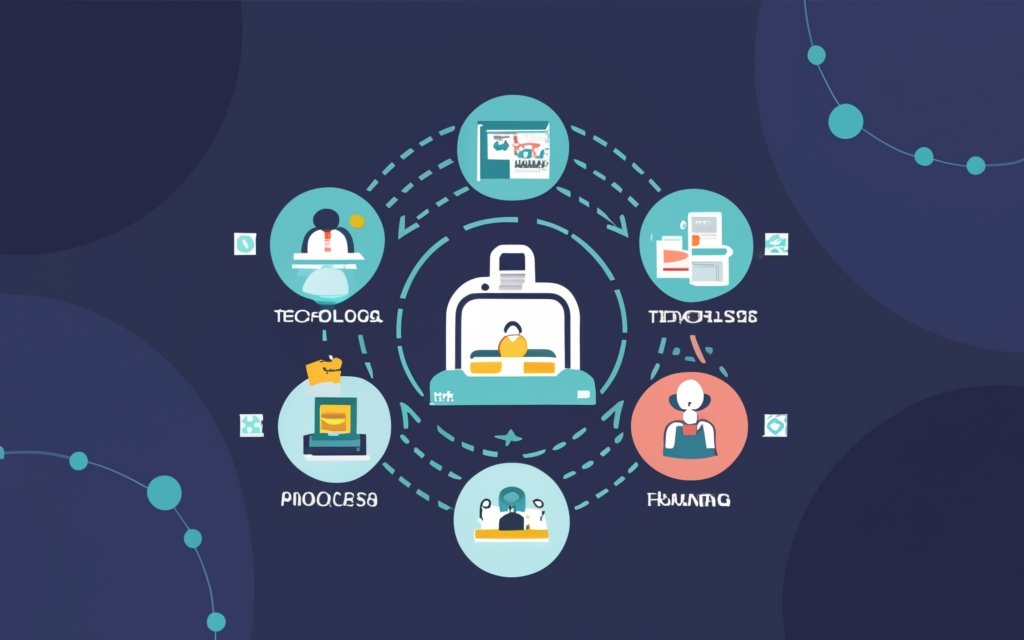Introduction: Cyber Resilience and Disaster Recovery
Cyber resilience refers to an organization’s ability to continuously deliver services and data even when faced with advanced cyber threats. Disaster recovery involves restoring systems and applications in case of disruption due to cyberattacks, system failures or natural disasters. Both cyber resilience and disaster recovery capabilities are crucial for effective cybersecurity.
Cyber resilience minimizes cyber risks while enabling organizations to adapt to evolving threats. Disaster recovery helps get critical systems back up within defined objectives post-disruption. Understanding the differences as well as synergies between the two can help strengthen overall security posture.
The Difference Between Cyber Resilience and Disaster Recovery
Cyber resilience is focused on resistance and continuous adaptation to cyberattacks before they lead to system failures. It encompasses security technologies, controls, processes and staff skills. Disaster recovery deals with restoring services after an incident through backup restoration, redundant systems etc.
Cyber resilience limits negative impacts through enhanced threat visibility, rapid responses and built-in redundancies. Disaster recovery aims to minimize downtime once systems have already been compromised via incident management and backup processes.
Both capabilities are vital– cyber resilience provides durable defense while disaster recovery handles inevitable breaches. They require different tools and approaches but have interdependent goals. Neglecting either leaves openings for cybercriminals to exploit.
Building Cyber Resilience: A Holistic Approach
Achieving genuine cyber resilience calls for extensive coordination between security technology, policies, processes, staff training and organizational leadership. It begins with identifying critical assets, determining risks and establishing target service levels during/post attacks.
New security tools should align with defined recovery goals while accounting for budget constraints and in-house expertise. Personnel need appropriate awareness and responsibilities regarding reporting, response, remediation and recovery procedures. Regular crisis simulations prepare for coordinated action under pressure.
With comprehensive preparation, threats become visible sooner and disruptions remain localized. Quick detections and responses limit spreads while continuity plans restore services. All stakeholders must unite behind resilience objectives through informed planning.
Disaster Recovery Planning: Recovering from Inadvertent Disasters
While cyber defenses deter direct attacks, inadvertent disasters like fires, floods and system failures can be equally as disruptive. Disaster recovery programs are vital for restoring business functions through tried-and-tested fallback arrangements independent of the trigger.
Effective plans classify systems/data criticality, analyze risks (internal or external), define resilience goals, assign roles and standardize response procedures. Regular backups are stored offsite while redundant infrastructure offers failover options until primary systems are restored.
Response teams have access to emergency contacts, system specs, step-by-step recovery instructions, spare part suppliers etc. Post-crisis analysis identifies new risk vectors and areas needing improved redundancy. The goal is minimizing human decision points through prepared policies and infrastructure.
The Cyber Resilience Scenario
Modern cyber resilience blends predictive security controls with adaptive processes using shared situational intelligence. As threats evolve, analytics uncover anomalies suggesting novel attack patterns or insider risks. Isolated systems then validate suspicions using advanced sandboxing techniques.
Confirmed threats trigger predetermined response protocols for containment through credential rotations, system segmentation and selective reversions to “last known good” settings. Forensics uncover root causes amid crisis while users face minimal disruptions from isolated containment measures thanks to built-in redundancy.
Ongoing defenses are bolstered through updated threat intelligence. Some seemingly normal activities may still conceal advanced persistent danger. Thus continuous monitoring alongside crisis readiness provides durable cyber resilience.
Table 1: Comparison of Cyber Resilience and Disaster Recovery
| Category | Cyber Resilience | Disaster Recovery |
| Goal | Adaptability and continuity during attacks | Restoring services post-disruption |
| Focus | Damage limitation through advanced security | Managing fallout after incident occurrence |
| Scope | Holistic integration of technology, processes and staff capabilities | Policies and infrastructure for service recovery |
| Key Metrics | Attack frequency, dwell time, spread limitation | Recovery time objective, recovery point objective |
| Requirements | Backup systems, redundancy, threat monitoring, crisis planning | Backups, redundant systems, emergency failover processes |
The Importance of Point-in-Time Images
Point-in-time backup images enable quick restoration to an operational state in both cyber resilience and disaster recovery scenarios. By periodically archiving system settings, they create recovery options from past working states unaffected by later incidents.
Comparison with the “last known good” image identifies suspicious subsequent changes– was a key configuration file altered? What task scheduled unauthorized jobs? When did the user manifest abnormal access attempts? This roots out dangers missed by routine monitoring.
Such images also circumvent disruption impacts through easy reversion after undesired changes or test environments. For smooth rollbacks, image parameters must precisely capture dependencies between connected systems. Images aid forensic investigation, shortened recovery and reduced tested fallbacks.
Cloud Deployment and Cyber Resilience
Cloud platforms offer innate resilience advantages over traditional data centers through abstracted infrastructure dependencies and global scale redundancy. Core network/compute instances are shielded from external threats while prompt resource provisioning aids continuity planning activations.
However clouds also demand updated security models considering accessible change execution and shared responsibilities. Critical evaluation is essential regarding external management access, encryption levels, activity monitoring scope and synergies between provider and customer crisis tools like snapshots.
Adequate cloud security resources must be allocated to match expanded attack surfaces and continuity requirements. Savings from cloud efficiency should funnel back into specialized talent able to unify cloud-native controls, in-house systems and resilient processes. The benefits of clouds in business continuity can only be realized through expert adoption.
Recovering from a Cyberattack: The Disaster Recovery Scenario
Recovering from external cyberattacks differs fundamentally from system failures in the absence of internal reference points for trust verification. Simply restoring compromised elements risks reintroducing dangers secretly embedded during prior intrusions.
Secure disaster recovery after cyberattacks requires extensive sandbox testing of restored systems to establish “clean” states before rehabilitation. Existing data may act as bait to detect dormant threats. Recovery prioritizes replacing tainted elements over retaining questionable legacy items.
Investments into threat hunting and forensic capabilities expedite accurate incident scoping amid crisis fog. Large attacks may require segmenting restoration across waves to resource impact analysis properly. Trust takes time to re-establish after breaches; disaster recovery plans should reflect this.
Incident Response and Root Cause Analysis
Effective incident response minimizes business disruption following either cyberattacks or operational incidents. Prioritizing critical functions helps maintain core revenue streams if full services remain unavailable. Stakeholders get real-time progress updates respecting compliance needs.
Root cause analysis uncovers the specific reasons behind recognized mishaps be they human errors, deficient access controls or overwhelmed systems. Identifying initial pain points drives targeted hardening to prevent recurrence in rebuilt or replacement infrastructure. Durable remedies require truthful understanding.
Ongoing cyber resilience requires continuous learning about residual weaknesses based on incident postmortems. Some uncovered risks manifest into future crises if left unaddressed. Consistent evaluation of recovery efforts contextualizes budgets, training and investments.
Legal and Regulatory Implications
Cyber resilience and disaster recovery capabilities have significant legal and regulatory implications across sectors like financial services and healthcare. Failure meeting recovery time/point objectives after outages leads to steep regulatory fines alongside customer distrust or legal action.
Many regulations explicitly mandate resilience requirements regarding encryption, retention, redundancy and restoration to safeguard sensitive data. Delivering compliant continuity and recovery architecture is no longer optional for enterprises handling critical information.
Regular external audits validate preparedness levels as per relevant statutes or contractual obligations. They also supplement internal impact analyses from tests or actual incidents. Prioritizing lawful continuity directly enables customer trust.
Conclusion: Surviving Inevitable Compromise
The modern digitized economy’s very foundation is resilient continuity of essential information services. As cyber threats expand exponentially, enterprises must minimize reliance on traditional perimeter defenses. Compromises should be expected not as flukes but inevitable incidents requiring a response plan.
Embracing this mentality demands viewing security as an intrinsic business priority rather than an isolated function. Technology alone cannot deliver resilience– policies, processes, personnel capabilities and leadership direction all play a role. It takes cross-departmental coordination and regular testing to contain the ripple effects from cyber events.
While individual solutions have their value, durable resilience occurs through the application of informed principles. With executive vision, practical preparation and realigned budgeting, organizations can survive inevitable compromises while fulfilling customer commitments. Prioritize critical functions, limit trust elevation, segment Juicy targets and always verify integrity following incidents– these tenets will sustain firms through the turbulent cyber age.
5 Key Questions regarding Cyber Resilience and Disaster Recovery:
- How can redundancy be built cost-effectively considering critical versus non-essential systems?
- What legal or contractual resilience obligations apply to sensitive organizational data?
- How frequently should disaster recovery plans be tested through simulated crisis scenarios?
- What safety mechanisms can minimize insider threats from privileged technical staff?
- Should organizations establish separate cyber insurance policies to offset recovery costs?

Richard Sena is a seasoned expert and thought leader in the rapidly evolving world of cryptocurrencies, blockchain, and decentralized finance (DeFi). With over five years of dedicated professional experience in this niche, Richard has become a respected voice in the crypto community. His journey into the world of cryptocurrencies began much earlier, fueled by a deep-seated passion for the transformative potential of blockchain technology and its myriad applications.
Richard’s expertise is not just limited to cryptocurrencies; he is deeply passionate about blockchain security and is always on the lookout for innovative solutions that enhance the robustness and resilience of blockchain systems. His work ethic is characterized by a relentless pursuit of excellence and a constant drive to refine and perfect his craft. As a team player, Richard believes in the power of collaboration and knowledge sharing, often working closely with others in the field to push the boundaries of what’s possible with blockchain technology.

